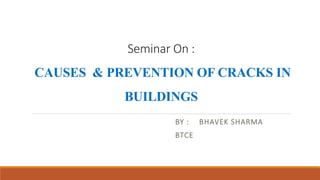causes & prevention of cracks
- 1. Seminar On : CAUSES & PREVENTION OF CRACKS IN BUILDINGS BY : BHAVEK SHARMA BTCE
- 2. About CRACKS Cracks in buildings are common occurrence. It develops when the stress in a component exceeds the strength. Classification of Cracks Structural crack Non Structural crack o Incorrect design o Faulty construction o Overloading o Internal induced stress in building material
- 3. Classification of Cracks Type Width Thin Medium Wide < 1 mm 1-2 mm > 2 mm Vertical Horizontal Diagonal Straight Toothed Stepped Map pattern Random Uniform throughout Narrow at one end and gradually widening at the other Based on width Based on sight of crack
- 4. Outline Introduction1 Causes of cracks2 Solutions & measures3 Techniques4
- 5. Internal stress in Building component oCompressive oTensile oShear oBuilding material ŌĆó Masonry, Concrete, Mortar ŌĆó Weak in tension/shear ŌĆó Causing tension/shear crack
- 6. PRINCIPAL CAUSES OF CRACKS IN BUILDING (Non structural) ’é¦ Thermal variation ’é¦ Chemical reaction ’é¦ Moisture movement ’é¦ Elastic deformation ’é¦ Creep ’é¦ Foundation movement & settlement of soil ’é¦ Vegetation ’é¦ Manufacturing defects Details in next few slides
- 7. Thermal variation ’é¦ It depends upon: temperature variation, dimensions, co-efficient of expansion, colour, surface characteristic, thermal conductivity, insulation, internally generated heat etc. ’é¦ When concreting is done in summer at high temperature, contraction due to drop in temperature in winter is high leading to thermal cracks. ’é¦ When roof in a load bearing structure undergoes expansion, horizontal cracks occur in cross walls as shown :
- 8. To prevent thermal variation cracks: ’āś Provision of expansion joints, slip joints, control joints ’āś Slab should be provided thermal insulation. ’āś Span of the slab should not be large. ’āś Slab should either project beyond the wall or rest only partially on the supporting wall.
- 9. Shear cracks
- 10. Moisture Movement: ’ü▒Reversible Movement -Material expands on absorbing moisture content -Shrinks on drying ’ü▒Irreversible movement -Material undergo some irreversible movement due to initial moisture change e.g. Shrinkage of cement on initial drying. ŌĆó Initial shrinkage in cement concrete and mortar depends upon: cement & water content, maximum size-grading-quality of aggregates, duration-method-temperature of curing, presence of excessive fines in aggregates, humidity, type of cement, temperature of fresh concrete etc.
- 11. Shrinkage cracks
- 12. Control shrinkage cracks: ŌåÆ Curing for at least 10 days, drying shrinkage is much less. ŌåÆ Presence of excessive silt, dust etc in sand and stone aggregates should not exceed 3%. ŌåÆ Shrinkage is much less in coastal areas due to high humidity ŌåÆ PPC and low grade OPC have much less shrinkage. ŌåÆ The ideal temperature range for concreting is 100C to 300C. ŌåÆ Sometimes cracks appear on freshly laid concrete even before it sets. This happens when rate of evaporation is higher than bleeding. In such circumstances, concrete should be covered with plastic sheet immediately after concreting and flood cured after initial set has occurred.
- 13. Measures to Control cracks (before construction) ’é¦ In structural concrete shrinkage cracks are controlled by using temperature reinforcement. Even in plain concrete a minimum 0.12% steel is recommended by IS: Codes. It is more effective if smaller diameter bars- closely spaced are used. ’é¦ Cracks in masonry can be minimized by using rich mortar and delaying plaster work till masonry has dried after curing. ’é¦ Cement plaster richer than 1:6 is harmful for external wall exposed to high temperature variations, since it will create a stronger membrane than the surface of brick. ’é¦ Coarse well graded sand should be used for plaster. Fine sand will result in crazy cracks.
- 14. Measures to Control cracks (before construction) ’é¦ Strong bond between concrete and plaster prevents shrinkage cracks, if rendering is done as early as possible after removal of shuttering. Key to plaster is provided by hacking and applying cement slurry just before rendering ’é¦ Shrinkage cracks affect the appearance and finish and not the structural stability. ’é¦ Cracks in walls generally get localized at weak sections, such as doors and window openings or staircase walls. In external walls shrinkage cracks generally run downwards from window sill to the lintel of the lower storey. ’é¦ Construction joint should be avoided in concrete. However if necessary it should be located at one-fourth of span away from preceding beam.
- 15. STRUCTURAL CRACKS: 1. Epoxy injection 2. Polyurethane injection 3. Stitching of cracks Problem Identification & techniques for repairing cracks Selection of suitable solution for cracks : AFTER CONSTRUCTION BHAVEK SHARMA
- 16. EPOXY INJECTION o Epoxy Grout Consists Of Epoxy Resin, Epoxy Hardener And Sand/Aggregates. oEpoxy Grout Is Non-porous And WouldnŌĆÖt Absorb Any Contaminant Or Stains
- 17. STRUCTURAL CRACKS: 1. Epoxy injection 3. Stitching of cracks 2. Polyurethane Injection BHAVEK SHARMA Problem Identification & techniques for repairing cracks Selection of suitable solution for cracks : AFTER CONSTRUCTION
- 18. POLYURETHANE INJECTION ’āś Polyurethane injection involves a high pressure (typically 1500-3200 psi) injection of activated polyurethane through injection packers hammered into drilled holes. ’āś These fast-setting foams are effective alternatives for applications involving only crack sealing (waterproofing) and not structural repair. Installed Injection Packer Polyurethane Crack Injection
- 19. STRUCTURAL CRACKS: 1. Epoxy injection 2. Polyurethane Injection 3. Stitching of cracks BHAVEK SHARMA Problem Identification & techniques for repairing cracks Selection of suitable solution for cracks : AFTER CONSTRUCTION Stitching of cracks
- 20. Thank you "SOMEWHERE, SOMETHING INCREDIBLE IS WAITING TO BE KNOWN."




















